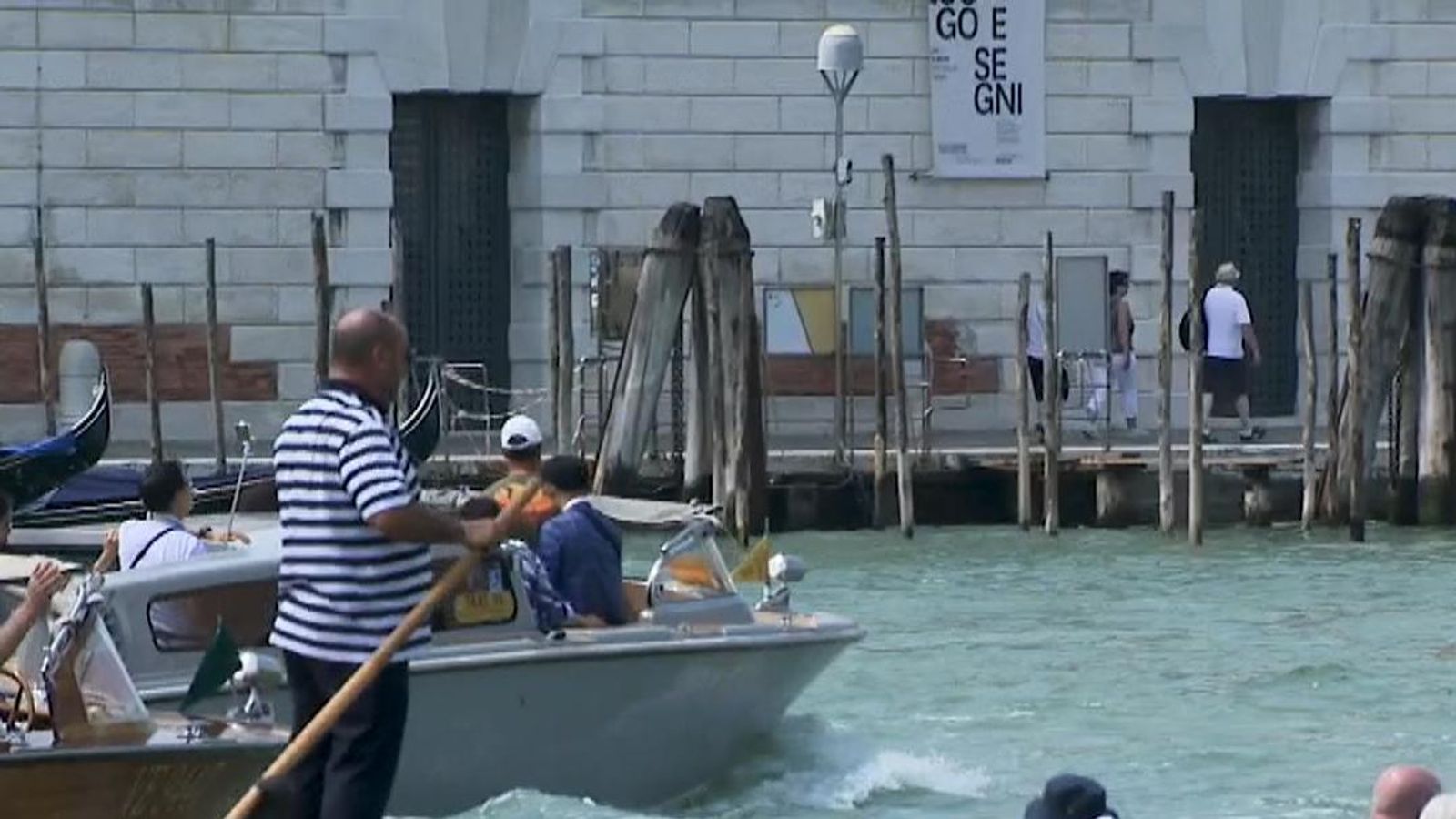Venice Is Sinking: A Radical Plan To Raise The City

Table of Contents
Venice, the jewel of Italy, is facing an existential threat: it's sinking. Rising sea levels and the increasingly frequent and severe acqua alta (high water) events threaten to submerge this iconic city forever, jeopardizing its unparalleled cultural heritage and delicate ecosystem. But a radical plan is underway, a multi-pronged approach combining innovative engineering with sustainable urban planning, to raise Venice, quite literally, and protect its future. This article explores the innovative solutions being implemented to combat the sinking of Venice and secure its continued existence for generations to come.
The Urgent Threat of a Sinking Venice
Rising Sea Levels and Acqua Alta: Climate change is dramatically accelerating the sinking of Venice. The Mediterranean Sea is rising at a rate faster than the global average, exacerbating the existing problem of acqua alta. These devastating floods, once a relatively rare occurrence, are now becoming more frequent and intense, causing millions of euros in damage and disrupting daily life for Venetians. The November 2019 flood, for example, served as a stark reminder of the city's vulnerability, causing catastrophic damage to historical buildings and infrastructure.
- Statistics: Sea levels around Venice have risen by approximately 20-30 cm over the past century, with projections showing a further increase of 30-100 cm by the end of the 21st century. Acqua alta events exceeding 100cm are becoming increasingly common.
- Impact: The economic impact is staggering. Flooding damages not only buildings and infrastructure but also severely impacts tourism, a cornerstone of the Venetian economy, leading to business closures and significant revenue losses. The cultural impact is equally devastating, with irreplaceable historical artifacts and artworks at risk.
The Vulnerability of Venice's Infrastructure: Venice's age-old infrastructure is particularly vulnerable. Many buildings are built on wooden pilings, which are decaying and increasingly susceptible to water damage. The very foundations of the city are slowly giving way, making it extremely fragile in the face of rising sea levels and severe flooding. The unique composition of the city’s subsoil also contributes to its instability.
- Examples of damage: Saltwater intrusion is causing significant damage to foundations and walls of historic buildings, leading to structural weakening and irreversible damage. The erosion of the lagoon floor further destabilizes the city.
- Challenges: Restoring and maintaining these historically significant structures while adapting them to the realities of climate change poses enormous challenges, requiring innovative conservation techniques and sustainable building practices.
The MOSE Project: A Controversial Solution
How MOSE Works: The MOSE (Modulo Sperimentale Elettromeccanico) project, a monumental flood barrier system, is the flagship attempt to protect Venice from acqua alta. This innovative system consists of 78 mobile gates strategically placed at the three inlets of the Venetian lagoon. These massive gates, normally submerged, rise to create a barrier when exceptionally high tides are predicted.
- Mechanism: Each gate is a sophisticated piece of engineering, consisting of large steel caissons filled with water or air to control their buoyancy. When needed, compressed air forces water out, causing the gates to rise and form a protective barrier.
- Protected areas: The MOSE system protects the historical center of Venice and its surrounding lagoon from flooding.
Criticisms and Challenges of MOSE: The MOSE project, despite its ambition, has been dogged by controversy. Cost overruns, significant delays, and allegations of corruption have marred its progress. Environmental concerns regarding the impact on the lagoon's ecosystem have also been raised.
- Cost and timeline: The initial projected cost was far exceeded, and the project experienced numerous delays, pushing its completion date back significantly.
- Environmental impact: Concerns exist about the system’s impact on water circulation and the delicate ecosystem of the Venetian lagoon. Studies are being conducted to mitigate these effects.
- Public perception: Public opinion on MOSE is divided, with some celebrating it as a necessary safeguard and others criticizing its costs and potential negative consequences.
Beyond MOSE: Alternative and Complementary Strategies
Sustainable Urban Planning: MOSE is not a complete solution; it's merely one component of a broader, long-term strategy. Sustainable urban planning is vital to ensure the long-term survival of Venice. This includes improving drainage systems, upgrading aging infrastructure, enforcing stricter building regulations for flood resilience, and implementing innovative water management techniques.
- Drainage systems: Modernizing the city's drainage network is crucial to quickly remove excess water from the streets during periods of high tide.
- Building regulations: Stricter building codes are needed to ensure new constructions are resilient to flooding and saltwater intrusion.
- Water management: Sustainable water management practices are essential to maintain the ecological balance of the Venetian lagoon and prevent further subsidence.
Community Involvement and Preservation Efforts: The future of Venice hinges on the active participation of its community. Citizen initiatives, educational programs, and fundraising efforts play a crucial role in preserving Venice's cultural heritage and promoting adaptation to the challenges of rising sea levels.
- Citizen initiatives: Local groups are actively involved in raising awareness, advocating for sustainable practices, and restoring damaged buildings.
- Educational programs: Educating both residents and visitors about the threats facing Venice and the measures taken to address them is crucial for long-term success.
- Fundraising efforts: Significant funds are needed to support conservation efforts, infrastructure improvements, and research into innovative solutions.
The Future of Venice: Hope and Uncertainty
The Long-Term Outlook: While MOSE offers a crucial level of protection against acqua alta, the long-term outlook for Venice depends on addressing the underlying causes of its sinking and implementing comprehensive, sustainable solutions. Projected sea level rise, even with MOSE in place, demands continuous adaptation and vigilance. The city needs to invest in ongoing maintenance, technological upgrades, and innovative solutions to ensure its survival.
- Sea level projections: Continued sea level rise will continue to pose a significant threat to Venice, requiring ongoing monitoring and adaptive strategies.
- Ongoing maintenance: The MOSE system will require regular maintenance and potentially upgrades to ensure its long-term effectiveness.
- Long-term sustainability: A holistic approach, incorporating sustainable urban planning, community involvement, and continued innovation, is crucial for Venice's long-term survival.
Conclusion:
The fight to save Venice from sinking is an ongoing battle requiring a multifaceted strategy. The MOSE project represents a crucial step, but its success hinges on parallel efforts in sustainable urban planning and community engagement. The future of this invaluable cultural treasure depends on our collective commitment to protecting it. Learn more and get involved in preserving Venice by supporting organizations dedicated to its preservation and researching innovative solutions to address the issues of rising sea levels and climate change. The time to act is now, to secure Venice's future for generations to come.

Featured Posts
-
 Rihannas Savage X Fenty A Heavenly Bridal Collection Unveiled
May 06, 2025
Rihannas Savage X Fenty A Heavenly Bridal Collection Unveiled
May 06, 2025 -
 From Craigslist To The Oscars Colman Domingos The Four Seasons Success Story
May 06, 2025
From Craigslist To The Oscars Colman Domingos The Four Seasons Success Story
May 06, 2025 -
 Tracee Ellis Ross On Dating Grief And Choosing Not To Settle
May 06, 2025
Tracee Ellis Ross On Dating Grief And Choosing Not To Settle
May 06, 2025 -
 Zendayas Half Sisters Public Attack Amidst Wedding Plans With Tom Holland
May 06, 2025
Zendayas Half Sisters Public Attack Amidst Wedding Plans With Tom Holland
May 06, 2025 -
 Miller To Nbc Details On His New Nba Analyst Position
May 06, 2025
Miller To Nbc Details On His New Nba Analyst Position
May 06, 2025
